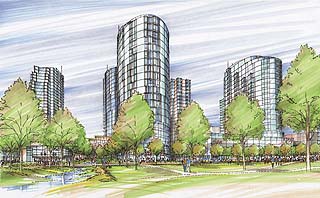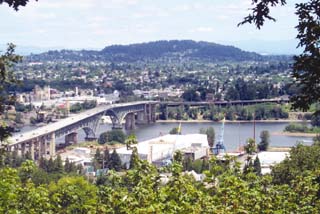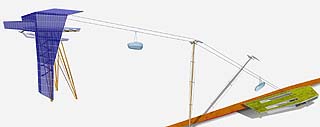
Surveys
DJC.COM
December 11, 2003
Portland's economic Rx: a biotech future
Journal Staff Reporter

Rendering courtesy of Busby + Associates Architects
Condo towers for Portland’s South Waterfront project will be slender to help preserve views.
|
As Seattle gears up to create a biotech hub at South Lake Union, the city of Portland is laying the foundation for what it hopes will be a successful biotech public/private partnership.
The first phase of Portland's $1.9 billion South Waterfront includes construction of two condo towers and a 250,000-square-foot research/outpatient care facility for Oregon Health & Science University. Construction on the OHSU building begins this month, and construction on the towers begins in March. The first phase is due for completion in early 2006.
Hoffman Construction is the general contractor for the OHSU building, and is in a joint venture with Ledcor for the condo towers project. The towers are designed by Busby + Associates Architects of Vancouver, B.C., in association with GBD Architects of Portland.
The three-phase, 20-year project will entail 2,700 housing units and 1.5 million square feet of OHSU buildings — primarily for research and clinical facilities, as well as a hotel/conference facility. The project will also include a 4-acre greenway for public use, and a 2-acre neighborhood park.
The city this summer reached an agreement with developer Homer Williams and North Macadam Investors LLC, obligating the city to spend $72 million in infrastructure improvements and open space.
“The agreement establishes the city's first true research and development corridor, a necessity for the continued vitality of OHSU and the city,” said Portland Mayor Vera Katz. “It strengthens the connection between our biosciences industries and the neighborhood with the rest of the city.” She called the Oct. 14 groundbreaking “a truly historic day for the city.”
Located just south of the downtown core, the 31-acre area known for decades as South Waterfront has drawn developers' interests. The industrial properties, though adjacent to bridges over the Willamette, offer views of the river, southeast Portland and Mount Hood. The area will be connected to downtown through buses and a new streetcar. In addition, the city and OHSU will build a $15 million tram connecting the hillside facilities of OHSU with the new waterfront structures.
With 8 percent unemployment, Portland has been hit hard by the recession and tech collapse. The city is searching for new economic catalysts and sees South Waterfront as an opportunity to entice biotech firms from California to Switzerland.

Photo by Sam Bennett
The South Waterfront project is planned in the industrial area seen in the foreground. |
Don Mazziotti, executive director of Portland Development Commission, said the city is attempting to recruit more than a dozen biotech firms. The city is hoping the development will create 10,000 jobs. OHSU is the city's largest private employer.
“In partnership with OHSU, it's our desire to create a dynamic, sustainable urban neighborhood that integrates the city's broad goals for job growth in one of our key industry sectors,” said Mazziotti, whose commission approved the development agreement before it went to the City Council. “The city has high aspirations for this project as the catalyst for future development in the area.”
The project will also address affordable housing needs by including 200 affordable apartments in the first phase of development. Phase I will also have about 650 market rate condos and apartments.
Overall, about 20 percent of the total project's housing units will be affordable. In addition, 75 percent of the towers' square footage is expected to meet LEED Silver standards. OHSU said it hopes to receive LEED certification for all its buildings on South Waterfront. Phase I construction is estimated at $440 million, and will last about four years.
Williams, a chief architect of the development agreement, conceded that the process leading to the approval of the agreement has been arduous. In addition to zoning changes and negotiations with property owners in the area, Williams needed the city's promise to help out with infrastructure improvements that would improve open space and transportation elements of the plan. For its part, the city had to calm the concerns among residents on hills just west of the development who didn't want their views of Mount Hood blocked by the condos or tram.

Rendering courtesy of Angelil/Graham/Pfenninger/Scholl Architecture
A 1.25-mile tram will carry people between the waterfront redevelopment site and Marquam Hill, where Oregon Health & Science University’s main campus is based.
|
Tram designer Angelil/Graham/Pfenninger/Scholl Architecture of Los Angeles crafted a design it says will tip-toe from the OHSU campus on Marquam Hill to the waterfront like a “ballet dancer,” by using thin, wooden towers. Similarly, Busby + Associates Architects is designing condo towers that will be thin like those found in Vancouver, B.C., to reduce view blockage looking east.
Though the city is in an economic rut, the South Waterfront development could spur Portland's potential as a biotech hub. Williams said the city's livability should also play a part. “OHSU is going to attract the talent that it wants to run its university because of the quality of life in the inner city,” he said.
Other Stories:
- Insights Program looks at commercial real estate
- Grocery stores cooking up more innovations
- Retail chic: Shopping centers with meeting places
- Development is changing; training should be, too
- When the government takes your property
- Don't get fenced in: Use a land title survey
- Are you paying too much property tax?
- A new corridor may be coming down the Pike
- Columbia City — the next hot spot?
- Yakima Valley real estate heats up
- Town centers rediscovered after years of neglect
- Northwest taps into waterfront properties
- David A. Sabey
- James N. Carbone
- John Solberg
- Mic Dinsmore
- Mark A. Weed
- The recovery train has left the station: Are we on it?
- Are hotels overbuilt or just overproposed?
- Tax credit program boosts low-income communities
- Interest rate hike could mean time to sell
- Debt can be good for nonprofits' projects
Copyright ©2009 Seattle Daily Journal and DJC.COM.
Comments? Questions? Contact us.